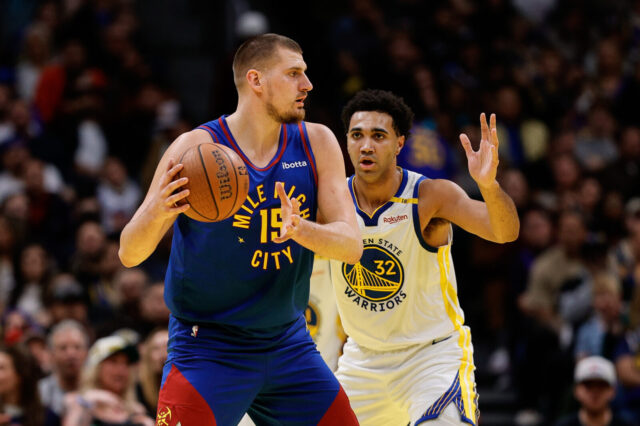Heading into 2015 the Nuggets rocky season has plagued them, and currently have a disappointing 15-20 record. Reflecting this, only four players currently have a positive Net rating. The highest Net rating of +5.1 belongs to the biggest bright spot of the season, rookie Bosnian center Jusuf Nurkic.
This positive net rating is due to a great defensive rating. While the offensive rating for Nurkic lineups is slightly worse than the team rating (100.8 vs 101.9) the defensive rating of Nurkic is 95.7. This mark compares with a 104.7 DefRtg for all team lineups and an even higher 106.7 DefRtg for all lineups not featuring Nurkic. This means teams are scoring a whopping 11 more points per 100 possessions in lineups without Jusuf compared with his on court numbers.
As ratings are a team measure, it is difficult to fully determine any individual players effect within them, but the ESPN measure Real Plus-Minus which attempts to do this, has Nurkic with the 11th defensive Real Plus-Minus rating in the NBA for centers (and 26th in the overall defensive rankings for all positions). The current sample size also restricts the amount of confidence in these numbers (and means they still prone to significant fluctuations), but the play of Nurkic has also looked good to the eye, so an analytic investigation of the statistics may offer another worthwhile view into what he is doing.
Focusing in
This content is no longer available.
To help pinpoint the areas of impact for Nurkic on the defensive side, the table above displays the Defensive and Four Factor ratings cross-referenced with Jusuf's court time.
Observations:
• The most significant of the four factors is the effect on opponents eFG% which is 5.7% lower for lineups featuring Nurkic than those without him.
•The next most impact is seen in the opponents turnover ratio which increases by 2.9% for Nurkic lineups.
Looking at each of the Four Factors individually
Opponents shooting breakdown
I turn first to breaking down the Effective Field Goal Percentages aka eFG% shown above using distance, breaking down both the percentage of team shots taken at each distance and the FG% hit (i.e. where opponents shoot and what % they hit). If Nurkic is impacting the shooting of opponents this should be seen most strongly in the expected defensive impact areas of a center i.e. in the paint and at the rim.
This content is no longer available.
The graph above shows the breakdown of where (by distance) opponents take their shots when Nurkic is on and off the floor.
Observations:
• While there are some small differences in where opponents are taking shots none of these differences are significant, indicating that Nurkic is having no significant effect on opponents shot spread.
This content is no longer available.
The graph above shows the breakdown of opponents FG% by distance when Jusuf is on and off the floor.
Observations:
• While the spread of shots above was unchanged by Nurkic's presence, we see here that the percentages at which opponents are shooting falls for all areas (except for three-pointers above the break).
• The biggest differences is present in the three-point corner, but this is likely to be due to small sample sizes rather than any significant effect by Nurkic.
While it is difficult to isolate the total individual effect of Nurkic on opponent FG%, indications from the breakdowns above are that the decreased opponent eFG% numbers are being influenced by the presence of Nurkic. Fortunately there is also another set of data that may offer some more individual insight on Jusuf's inside influence.
This content is no longer available.
The table above shows a number of Statistics from the SportVU data available on NBA.com/stats. The top section of the table contains distance measures, used to record rim protection. For comparison, by limiting to a minimum of 10 games, at least 1 block per game and a minimum of four opponent FGs contested at the rim per game, and then ranking by the opponent field goal percentage at the rim, Nurkic's numbers rank at number 13 in the NBA. This places him in the company of a number of well regarded rim protectors, and indicates that the team statistical data above suggesting his effect on FG% near the rim are backed up by the player tracking camera data.
This is further reinforced by the defensive shot data that compares the FG% of the offensive players who have been being defended with their normal % to gauge the shot defense effect of the player. Nurkic's numbers show that players have shot worse in all of the (sometimes overlapping) zone categories when he is defending them.
Strong differences are seen at the short distances with less than 6-feet at -8.4% and shots less than 10-feet having a -5.8% decrease in the FG% of players (weirdly there is an effect on three-pointers again at -10.9%, but like in the shot data above this is again likely mostly due to the small sample size involved).
Opponents Free Throw Attempted Rate
This category is the one negative of lineups featuring Nurkic, and as he is the league ‘leader' in per 48min foul rate (10 game minimum). it is likely that he is having some effect on increasing the opponents free throws attempted rate either by sending them to the line directly or getting opponents into the bonus quicker.
The Nuggets are currently the ‘foulingest' team in the NBA and so some of this may be related to the way the team is playing defense, but Nurkic came to the NBA with a reputation for fouling, and this seems to have transferred to his early career play. Many young players struggle initially with fouls so there is no reason to think this is not correctable as Nurkic gains experience.
While Nurkic has great hands that can lead to steals (see below) he has a tendency to reach in at the wrong time (on occasion). In the following example Nurkic reaches in on Chris Paul while he is defending on the move in full view of the referee.
While as a center Nurkic is likely to continue to pick up some fouls defending the paint if he can at least cut out these sort of rookie mistakes, he should be able to lower his foul rate to reasonable levels.
Opponent Turnover Ratio
A problem for the Nuggets this season has been forcing turnovers, they are currently 24th in the NBA in opponents turnover ratio. In lineups featuring Nurkic this stat shows good improvement (the Nurkic lineup rate of 15.6% would place 12th in the NBA for teams). Some of this may be from playing with active defenders such as Darrell Arthur, Gary Harris and Alonzo Gee, but Nurkic is also very active on the defensive end. He is able to use his long arms and quickness to gain steals, blocks, and disrupt the defense with deflections. Currently his block rate is second on the team to JaVale McGee and his steal rate is third (behind Harris and Arthur). While his activity can sometimes lead to fouls (as shown above), when he uses his quick feet and long arms in the right situations he has shown good 1-on-1 defensive skills even on the perimeter.
In the following clip, Nurkic ends up against one of his heroes: Kobe Bryant. Not only is he able to deflect the ball not once but twice, but he prevents Bryant from being able to drive past him and in the end Kobe is forced into a terrible shot to beat the shot clock.
Jusuf even had a few choice words for Bryant at the end of that play, which is another tendency he has demonstrated this season. Many Nuggets fans loved the recent battle Nurkic had with Marc Gasol, and the fact he has not backed down from the challenge of playing against the best in the NBA. As long as he can continue to funnel his aggression and confidence positively it should be an asset for him.
Opponents Offensive Rebounding Percentage
Nurkic's rebounding ability has been one of the early stand outs of his play and his per 48min rebounding rate places Jusuf 8th in the NBA in defensive rebounding and 5th in the NBA (10 game min) in total rebound rate.
This however has not has much effect on decreasing the opponents offensive rebound rate when he is on the floor with only a small positive effect of 1.1% over when he is off court. The main reason for this is likely the fact that Denver is a good rebounding team anyway, ranking 8th in defensive rebounds per game (and 2nd in total rebounds per game). While the effect on the team numbers is not large, rebounding is certainly one of Jusuf's big strengths, and unlike a player like Faried who uses energy and athleticism to be a great rebounder, Nurkic employs his size and especially great positioning to gain rebounds.
In the example above Nurkic does a good job of covering his man (Kosta Koufos) while also watching the ball – meaning he is able to cover his defensive responsibilities and also position himself to be in the best place to rebound the ball after the miss.
Conclusion
It's hard to quantify an individual players full impact on defense. A number of different statistical measures used above, as well as camera tracking data, all match with the eye test to strongly indicate that Jusuf Nurkic is already a positive force on defense for the Nuggets. If he can continue in this vein, his playing time should also continue to increase and will likely be limited only by his fouling issues. While he is just a rookie, he is already beginning to make waves in the NBA and I personally believe with the unique skills and the ceiling he has shown, the front office should already be planning their future moves with building around Nurkic firmly in mind.
All statistics taken from NBA.com/stats, ESPN.com, and NBAwowy and current to Jan 4th 2015.


